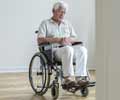The paralysis associated with spinal cord injury can be treated effectively by ependymal stem cells, says study.
Stem cells transplantation from the lining of the spinal cord, called ependymal stem cells, can reverse paralysis associated with spinal cord injuries in laboratory tests, a new study has found.
Results indicate that the population of these cells after spinal cord injury was many times greater than comparable cells from healthy animal subjects. The results open a new window on spinal cord regenerative strategies.It was found that the transplanted cells proliferate after spinal cord injury and were recruited by the specific injured area.
On transplantation into animals with spinal cord injury, the stem cells regenerated ten times faster while in the transplant subject than similar cells derived from healthy control animals.
Spinal cord injury is a major cause of paralysis, and the associated trauma destroys numerous cell types, including the neurons that carry messages between the brain and the rest of the body.
In many spinal injuries, the cord is not actually severed, and at least some of the signal-carrying nerve cells remain intact. However, the surviving nerve cells may no longer carry messages because oligodendrocytes, which comprise the insulating sheath of the spinal cord, are lost.
The newly discovered regenerative mechanism was activated when a lesion formed in the injured area, following which the stem cells were found to have a more effective ability to differentiate into oligodendrocytes and other cell types needed to restore neuronal function.
Advertisement
"The human body contains the tools to repair damaged spinal cords. Our work clearly demonstrates that we need both adult and embryonic stem cells to understand our body and apply this knowledge in regenerative medicine.
Advertisement
The study is published in the journal Stem Cells.
Source-ANI
PRI/SK















